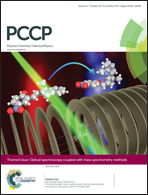Ab initio calculation of electronic charge mobility in metal–organic frameworks†
Abstract
A density functional theory approach coupled with the Boltzmann transport equation within the relaxation time approximation was used to investigate the charge mobility for three MOF functionalization designs. The specific MOF investigated was a Zr-UiO-66 MOF with three functionalizations that included benzenedicarboxylate (BDC), BDC functionalized with an amino group (BDC + NH2), and BDC functionalized with a nitro group (BDC + NO2). Previous experimental studies have confirmed a 40% decrease in the optical band-gap with functionization; this study predicted an accompanying decrease in mobility by 14%. On the contrary, the charge density was found to increase with functionalization. The culmination of these two findings resulted in a predicted conductivity of approximately 3.8 × 10−8 S cm−1 for BDC design and decreasing less than 2% for other cases. Furthermore, band conduction was confirmed for this MOF design as a result of the de-localized π electron of the carbon atoms along the organic linker. Overall, the functionalization proved to decrease mobility; however, it was evident that the functionalization has potential for tailoring the spectral layout of low lying unoccupied orbitals and ultimately the charge concentration, which could prove to be important for increasing the overall conductivity of MOFs.


 Please wait while we load your content...
Please wait while we load your content...